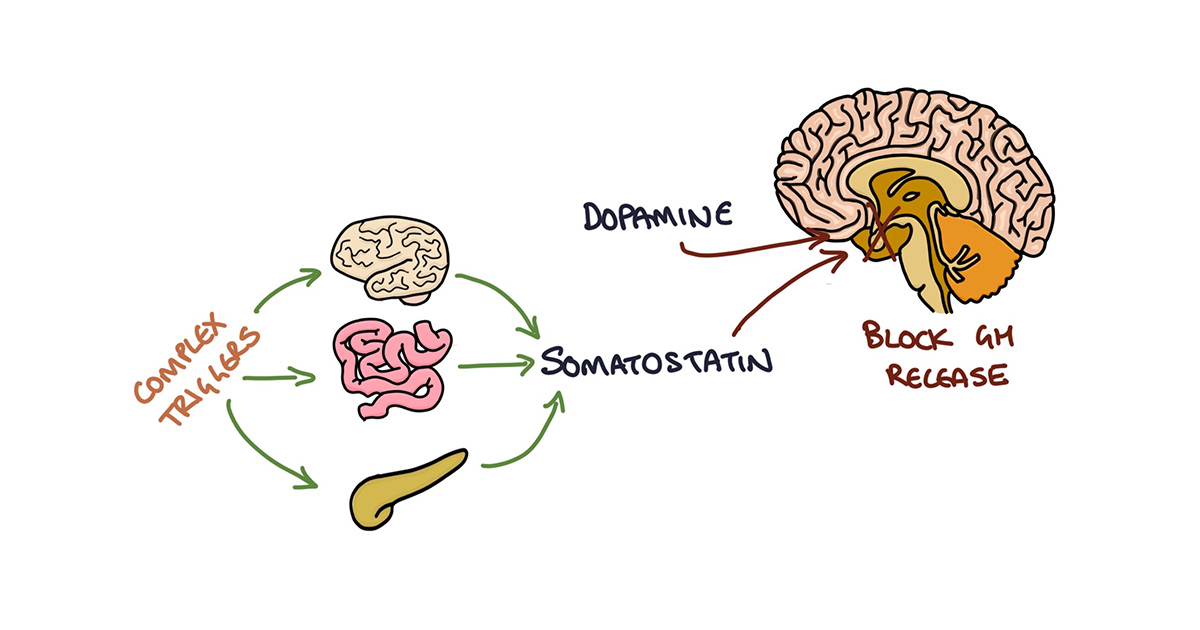Understanding acromegaly and explaining it to others is a crucial element to raising awareness of this rare disease. This simple visual explanation of acromegaly is brought to you by Zero To Finals. In this video, they cover the presentation (including the pathophysiology of bitemporal hemianopia) and management. Management involves dopamine agonists such as bromocriptine, somatostatin analogs such as octreotide and transsphenoidal surgery to remove a pituitary adenoma if this is the cause.

*This video is intended to help with the education and understanding of students of healthcare professions only and is not medical advice. For medical advice see your doctor or other healthcare professional. Whilst significant effort has been taken to make the information accurate it cannot be guaranteed.
What is acromegaly?
Acromegaly is the clinical manifestation of excessive growth hormone (GH). Growth hormone is produced by the anterior pituitary gland, the most common cause of unregulated GH is a pituitary adenoma, a hormone-secreting tumor. This tumor might be microscopic, so small that you cannot even see it on a scan, or it can be significantly sized so that it causes compression of the local structures.
Rarely acromegaly can also be secondary to cancer like a lung or pancreatic cancer that secretes either ectopic growth hormone-releasing hormone (GHRH)or ectopic growth hormone itself.
There is a structure called the optic chiasm and this sits just above the pituitary gland and what this optic chiasm is, is the point where the optic nerves coming from the eyes cross over to different sides of the head and enter into the occipital lobe which interprets visual signals.
A pituitary tumor that has significant size will start to press on this structure called the optic chiasm and pressure on the optic chiasm will lead to stereotypical bitemporal hemianopia (visual field defect) so what this is, is basically a loss of vision of both of the outer halves of the eyes because as the visual signals from the optic nerve come through the optic chiasm, the signals that send the outer part of the visual field cross over in the middle and it’s this middle part that is pressed on by the tumor and this causes loss of vision of the outer sides of the eyes.
How does acromegaly present?
If there is a space-occupying lesion or a significant sized tumor you might find somebody with headaches known as bitemporal hemianopia. It can also present as an overgrowth of tissues secondary to the growth hormone. So patients typically present with a prominent forehead and a brow that we call frontal bossing. They can have a large nose, a large tongue which we call macroglossia. they can have large hands and large feet, a protruding jaw which we call prognathism. They can develop arthritis from the imbalanced growth of tissues around the joints.
Growth hormone can also cause organ dysfunction because it causes the growth of tissues outside of the muscles in the skeleton such as a hypertrophic heart very large heart that is not functioning properly, it can cause hypertension, type 2 diabetes, and it is also linked to colorectal cancer.
How do you treat acromegaly?
Well, you need to remove the source of that excessive growth hormone, so if you have a pituitary tumor you can do an operation where you go through the nose and the sphenoid bone at the front of the face and surgically remove that pituitary tumor and that’s the definitive treatment for acromegaly in patients who have. pituitary adenomas. Where acromegaly is caused by ectopic hormones from say a pancreatic or lung cancer then surgical removal of those cancers is also an effective treatment.
If it’s not possible to remove the cause of the excessive growth hormone then there are medications that can be used to block the growth hormone. There’s a medication called pegvisomant and this is a growth hormone antagonist that’s given subcutaneously and daily, more commonly we use somatostatin analogs which also block growth hormone, remember that somatostatin is known as growth hormone inhibiting hormone and an example of the somatostatin analogs is something called octreotide. Dopamine agonists also block growth hormone release so this is things like bromocriptine that you might have heard of being used in Parkinson’s disease.
Just a bit of extra information somatostatin is normally secreted by the brain gastrointestinal tract and pancreas in response to complex triggers and one of the functions of that somatostatin is to block growth hormone release from the pituitary gland. Dopamine also has an inhibitory effect on growth hormone release but it’s not as potent as somatostatin so that’s why we use somatostatin analogs and dopamine agonists to help us block growth hormone release when you have a patient with acromegaly.

